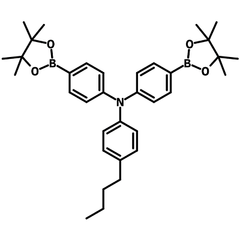4-Butyl-N,N-bis(4,4,5,5-tetramethyl-1,3,2-dioxaborolane-4-phenyl)aniline
CAS Number 444289-55-8
Boronates, Chemistry Building Blocks, Heterocyclic Building Blocks, Materials, Monomers4-Butyl-N,N-bis(4,4,5,5-tetramethyl-1,3,2-dioxaborolane-4-phenyl)aniline , Triphenylamine derivative building block
A convenient boronic ester with alkyl solubilizing group for the synthesis of hole transport semiconducting small molecules and polymers in application of organic light-emitting devices and perovskite solar cells.
Specifications | MSDS | Literature and Reviews
4-Butyl-N,N-bis(4,4,5,5-tetramethyl-1,3,2-dioxaborolane-4-phenyl)aniline, CAS number 444289-55-8, produced normally from 4-bromo-N-(4-bromophenyl)-N-(4-butylphenyl)aniline reacting with bis(pinacolato)diboron, is a convenient building block used for the preparation of semiconducting conjugated polymers as emitting layer, phosphorescent host or hole transport layer materials in application of OLED and perovskite solar cells devices. A typical example of such materials is polyTPD which is widely used as hole transport layer in such devices.
π-conjugated polymer poly(triphenylamine-carbazole) (PTC-U), mimicking a DNA in structure, exhibits high thermal stability, excellent hole injection and electron-blocking abilities in films owing to the uracil induced physical cross-linking.
A fluorene and triarylamine back-boned copolymer PFA-OXD shows bipolar charge transporting functionalities by incorporating electron-deficient oxadiazole pendent groups onto the C9 position of the fluorene repeating units. A high-brightness, highly efficient red electroluminescent device having a maximum brightness of 28, 440 cd m-2 was further demonstrated by doping PFA-OXD with a red-emitting phosphorescent dye, Os(fppz).
General Information
| CAS Number | 444289-55-8 |
| Chemical Formula | C34H45B2NO4 |
| Molecular Weight | 553.35 g/mol |
| Full Name | 4-Butyl-N,N-bis(4,4,5,5-tetramethyl-1,3,2-dioxaborolane-4-phenyl)aniline |
| Synonyms | 4-Butyl-N,N-bis(4-(4,4,5,5-tetramethyl-1,3,2-dioxaborolan-2-yl)phenyl)aniline |
| Classification / Family | Triphenylamine derivatives, Semiconductor synthesis intermediates, Hole transport layer, Perovskite solar cells |
Chemical Structure

Product Details
| Purity | >98% (1H NMR) |
| Melting Point | N/A |
| Appearance | White to off-white powder/crystals |
MSDS Documentation
4-Butyl-N,N-bis(4,4,5,5-tetramethyl-1,3,2-dioxaborolane-4-phenyl)aniline MSDS Sheet
Literature and Reviews
-
A New Supramolecular Hole Injection/Transport Material on Conducting Polymer for Application in Light-Emitting Diodes, Y. Chu et al., Adv. Mater., 24 (14), 1894-1898 (2012); DOI: 10.1002/adma.201103866.
-
Synthesis and characterization of triphenylamine-based polymers and their application towards solid-state electrochromic cells, J. Jeong et al., RSC Adv., 6, 78984-78993 (2016); DOI: 10.1039/C6RA12112H.
-
Stimuli-responsive supramolecular conjugated polymer with phototunable surface relief grating, C. Huang et al., Polym. Chem., 9, 2813-2820 (2018); DOI: 10.1039/C8PY00439K.
